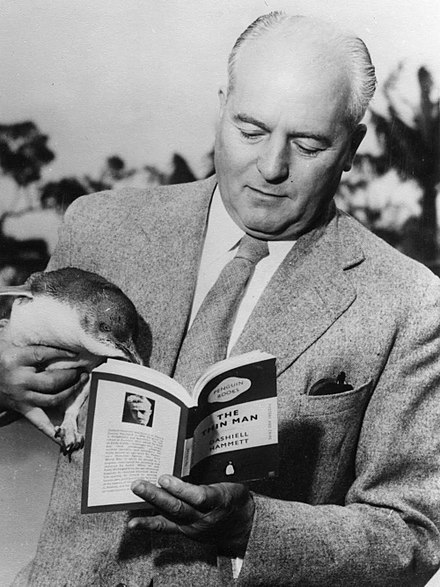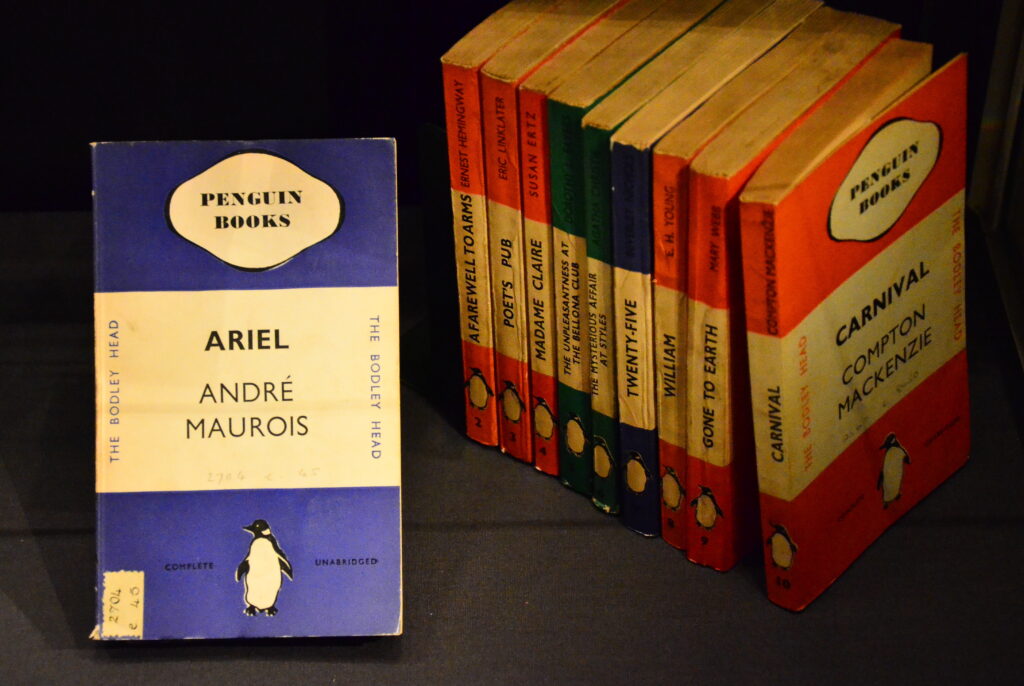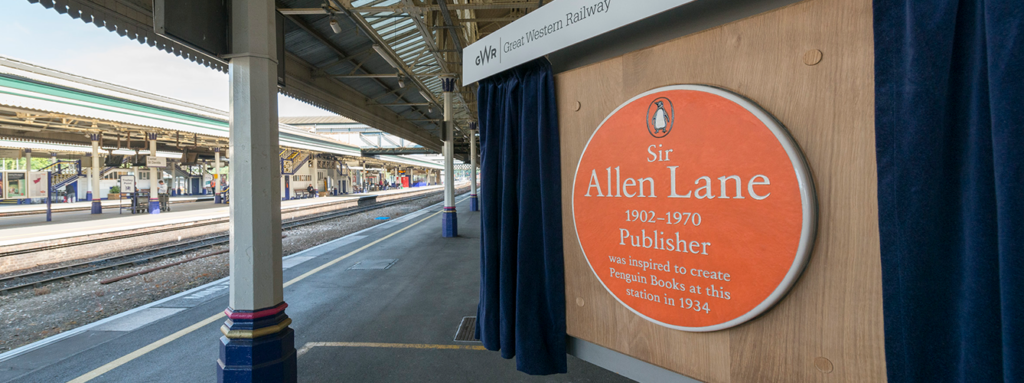Penguin books really don’t need any introduction, your shelves are probably lined with them. But as they are one of the few publishers in our new books section, a bit of background on how they came to be …
Origins

It was the 1930s and Allan Lane, the managing director of the publishing company The Bodley Head, was annoyed by the poor quality of reading material on offer at Exeter train station. That, and the drama around the publishing of James Joyce’s controversial book Ulysses by Bodley, inspired him to create cheap, well-designed quality books for the mass market. So he and his brothers Richard and John founded Penguin to fill that void. The first Penguin paperbacks were published in 1935, but at first only as an imprint of The Bodley Head, with the books originally distributed from the crypt of Holy Trinity Church Marylebone.
Inexpensive paperbacks did not initially appear viable to Bodley Head, since the deliberately low price made profitability seem unlikely. This helped Lane purchase publication rights for some works more cheaply than he otherwise might have since publishers were convinced of the business’s short-term prospects. In the face of resistance from the traditional book trade, it was the purchase of 63,000 books by Woolworths Group that paid for the project outright, confirmed its worth, and allowed Lane to establish Penguin as a separate business in 1936. By March 1936, ten months after the company’s launch on 30 July 1935, one million Penguin books had been printed.
In 1937 Allen Lane launches a non-fiction imprint after overhearing someone at a King’s Cross station bookstall mistakenly ask for “one of those Pelican books”. The first Pelican book is George Bernard Shaw’s The Intelligent Woman’s Guide to Socialism, Capitalism, Sovietism and Fascism followed by titles including A Short History of the World by H.G. Wells.
Penguin Books Inc was incorporated in 1939 to satisfy US copyright law; and, despite being a late entrant into an already well established paperback market, enjoyed further success. From the outset, design was essential to Penguin’s success.

Legendary Penguin designs
Avoiding the illustrated gaudiness of other paperback publishers, Penguin opted for the simple appearance of three horizontal bands, the upper and lower of which were colour-coded according to the series to which the title belonged; this is sometimes referred to as the horizontal grid. In the central white panel, the author and title were printed in Gill Sans, and in the upper band was a cartouche with the legend “Penguin Books”. The initial design was created by then-21-year-old office junior Edward Young, who also drew the first version of the Penguin logo.
The colour schemes included: orange and white for general fiction, green and white for crime fiction, cerise and white for travel and adventure, dark blue and white for biographies, yellow and white for miscellaneous, red and white for drama; and the rarer purple and white for essays and belles lettres and grey and white for world affairs. Lane actively resisted the introduction of cover images for several years. Some recent publications of literature from that time have duplicated the original look.

The war years
The Second World War saw Penguin emerge as a national institution. Though it had no formal role in the war effort, it was integral to it thanks to the publication of such bestselling manuals as Keeping Poultry and Rabbits on Scraps and Aircraft Recognition, and supplying books for the services and British POWs. In the war’s six years, it printed some 600 titles and started 19 new series. At a time of enormous increase in the demand for books, Penguin enjoyed a privileged place among its peers.
Paper rationing was the besetting problem of publishers in wartime. When rationing was introduced in March 1940, the Ministry of Supply allocated a quota to each publisher as a percentage of the amount that firm used between August 1938 and August 1939. This was particularly advantageous to Penguin, who, as a volume printer, was very successful that year. Further, in a deal with the Canadian Government, Penguin agreed to exclusively publish editions for their armed forces, for which they were paid in tons of paper.
The first four Puffin Picture Books are published in 1940 with the aim of helping evacuated city children adjust to life in the country. Titles such as War on Land are such a success that they are quickly followed by fiction. One title is Orlando the Marmalade Cat, the hero of 19 books between 1941 – 1972.
By January 1942 the Book Production War Economy Agreement regulations came into force which determined rules on paper quality, type size and margins. Consequently, Penguin eliminated dust jackets, trimmed margins and replaced sewn bindings with metal staples. Aside from the noticeable deterioration in paperbacks’ appearance, it became a practical impossibility to publish books of more than 256 pages, resulting in some titles falling out of print for want of material. In addition to their paper allocation, in 1941 Penguin secured a deal with the War Office to supply the troops with books through what was known as the Forces Book Club. Penguin received 60 tons a month from Paper Supply in return for 10 titles a month in runs of 75,000.
Originally, every paperback carried the message, “FOR THE FORCES – Leave this book at a Post Office when you have read it, so that men and women in the Services may enjoy it too” at the bottom of the back cover, inviting the reader to take advantage of the Royal Mail’s free transmission of books to the forces. However, demand exceeded supply on the home front, leading Lane to seek a monopoly on army books made specifically for overseas distribution. Their established paper supply put Penguin in an especially strong position after the war as rationing continued. For this reason, and for the popular prestige the company enjoyed, many of Penguin’s competitors had no choice but to concede paperback reprint rights to it.
Post-war history
In 1945, Penguin began what would become one of its most important branches, the Penguin Classics, with a translation of Homer’s Odyssey by E. V. Rieu. The German typographer Jan Tschichold redesigned 500 Penguin books, and left Penguin with a set of influential rules of design principles brought together as the Penguin Composition Rules. Tschichold’s work included the woodcut illustrated covers of the classics series (also known as the medallion series), and with Hans Schmoller, the vertical grid covers that became the standard for Penguin fiction throughout the 1950s. Many other series were published such as the Buildings of England, the Pelican History of Art and Penguin Education.
By 1960, a number of forces were shaping the direction of the company, the publication list and its graphic design. New techniques such as phototypesetting and offset-litho printing were to replace hot metal and letterpress printing, dramatically reducing cost and permitting the printing of images and text on the same paper stock, thus paving the way for the introduction of photography and novel approaches to graphic design on paperback covers. In May 1960, Tony Godwin was appointed as editorial adviser, rapidly rising to Chief Editor from which position he sought to broaden the range of Penguin’s list and keep up with new developments in graphic design. He hired Germano Facetti in January 1961, who was to decisively alter the appearance of the Penguin brand. Marber suggestion of what came to be called the Marber grid along with the retention of traditional Penguin colour-coding was to replace the previous three horizontal bars design and set the pattern for the design of the company’s paperbacks for the next twenty years. Facetti rolled out the new treatment across the Penguin line starting with crime, the orange fiction series, then Pelicans, Penguin Modern Classics, Penguin Specials, and Penguin Classics, giving an overall visual unity to the company’s list. A somewhat different approach was taken to the Peregrine, Penguin Poets, Penguin Modern Poets, and Penguin Plays series. There were over a hundred different series published in total.

Later years
By the end of the 1960s Penguin was in financial trouble, and several proposals were made for a new operating structure. Sir Allen Lane died on 7 July, and six weeks later, Penguin was acquired by Pearson PLC on 21 August 1970. A new emphasis on profitability emerged and, with the departure of Facetti in 1972, the defining era of Penguin book design came to an end.
Penguin merged with long-established U.S. publisher Viking Press in 1975. The first Penguin Bookshop opened in Covent Garden in 1980.
In 1985, Penguin purchased British hardback publisher Michael Joseph and in 1986, Hamish Hamilton. After these acquisitions, Penguin moved its offices to central London. Thus ‘Harmondsworth’ disappeared as the place of publication after half a century.
Also in 1986, Penguin purchased American publisher New American Library (NAL) and its hard-cover affiliate E. P. Dutton. New American Library had originally been Penguin U.S.A. and had been spun off in 1948 because of the high complexity of import and export regulations. Penguin repurchased it in order to extend its reach into the US market, and NAL saw the move as a way to gain a hold in international markets.
In 1998 Random House UK is acquired by Bertelsmann and merges with Bertelsmann’s UK operation Transworld Publishers to create the Random House Group Ltd. The Random House Group acquires a majority shareholding in BBC Books – a publishing imprint of Ebury, in 2006. Penguin and Random House merged in 2013.
2008 – Penguin publishes its first-ever ebooks. Titles include A Room of One’s Own, King Lear and Utopia.
An orange commemorative plaque was unveiled at Exeter train station in May 2017 to mark Lane’s significant contribution to the publishing industry.

The text is a mixture of Wikipedia and the official Penguin Random House page.

